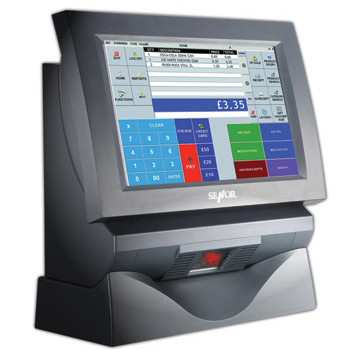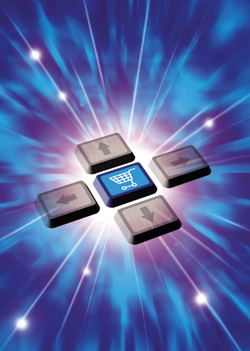A year in Retail Tech

As the year draws to a close, we take a look back at the technology highlights of 2008 and reveal a sneak preview of what’s to come
8 December 2008
 It is impossible to have a discussion on the latter half of 2008 without mentioning the “R” word. A year that started reasonably brightly has ended up a dream for the doom and gloom merchants that have been predicting economic upheaval for years; based upon the premise that if they kept repeating it year-in-year-out they would one day be right.
It is impossible to have a discussion on the latter half of 2008 without mentioning the “R” word. A year that started reasonably brightly has ended up a dream for the doom and gloom merchants that have been predicting economic upheaval for years; based upon the premise that if they kept repeating it year-in-year-out they would one day be right.
It looks as if 2009 will also be dominated by the economic conditions and knock-on effects of the financial crisis in the money markets. While growth in the faltering economy was expected to slow, the panic in the financial markets has added an extra dimension that many did not see coming.
So what will all this mean for retailers and their tech suppliers? How was 2008 and will next year prove a happy hunting ground for the retail tech sector?
A forecourt first in Ireland
David MacHale of Forecourt Systems said 2008 saw the launch of one of the company’s biggest projects; a fully integrated pay-at-the-pump system. According to MacHale it was the first of its kind to be launched in Ireland, with integrated Epos, chip & pin compatability, and credit card and fuel card applications all in one.
“We feel it’s a great product because it’s one that the retailers and their customers have been screaming out for for years.” MacHale also believes that ‘08 was a huge year in relation to the new technologies in the forecourt retailing IT sector.
He said the previous five years had seen very few outstanding and genuinely innovative solutions emerge in the sector. “I think pay-at-the-pump is a great new solution that all retail IT companies will be wishing to provide in the forecourt sector in the coming year.”
Looking ahead to 2009, MacHale sees cashless payment systems as the biggest development in the forecourt area. “Petrol is an expensive commodity for the retailers to suffer losses on, and I think all moves towards pre-pay, RFID and chip & pin solutions will help forecourt owners better secure their business.”
With governments worldwide scrambling to counter the effects of the economic malaise MacHale believes the economy will have an effect on the forecourt tech business in 2009. He believes some retailers will undoubtedly hold off investing in their business until a clearer picture emerges of what will happen in the marketplace.
“However, in the forecourt sector, businesses that are proving barely profitable now have the option to go unmanned which was unheard of in this country before. We expect good investment in this side of our business in 2009.”
MacHale also believe retailers will be investing in tech solutions next year. “I feel they will spend more in security based solutions, such as CCTV and pay-at-the-pump, to help enable return on investment (ROI) through a reduction in drive-offs. We expect some of the larger oil companies to continue to spend in the more cost-effective and hi-tech payment systems to help them reduce costs and increase control over their nationwide chains.”
Digital video recording
Dominic Feeney, systems director at CBE said the most important product it was involved with in 2008 was its integration with DVR systems. This facilitated the complete incorporation of the Epos system with the DVR security system and allowed retailers get live video footage from any of their cameras directly on to their Epos structure.
Feeney said the true power of this is proven in forecourts when integrated with pumps. Once a nozzle is lifted the Epos system instructs specific fixed cameras to obtain still images of the number plate of the vehicle at the pump and the person fuelling the vehicle. In tandem with this a PTZ camera is instructed to obtain footage of the entire transaction and this live footage as well as the still images are available immediately on all Epos units.
“One forecourt reported a reduction in drive-offs by over 60 % within three weeks of installing this solution.”
Greater integration
Feeney said the main differences comparing 2007 and 2008 was the move towards greater integration of services and the focus on maintaining margin. He said by putting together services on Epos such as integrated bill payment facilities the retailer is able to drive footfall by offering consumers greater convenience and flexibility.
“Loyalty offerings have also advanced quite a bit over the last year and more and more retailers are now offering these schemes to their customers which can vary from quite basic yet functional to sophisticated solutions, but they all fundamentally allow the retailer to differentiate themselves from their competitors and enable the retailer to offer something back to the consumer.”
Feeney also said improved reporting, better presentation of information and a focus on ‘exception’ transactions has made it easier for retailers to manage their margins. “By presenting information graphically and by producing specialist reports to highlight abnormal transactions retailers are able to react quickly and decisively to pertinent information.”
Self check-out
According to Feeney the biggest development that CBE has for 2009 is its self check-out solution for supermarket and convenience stores.
Feeney claimed CBE is the first company to be able to offer self check-out to the independent/symbol group retailer in Ireland. “There is a very clear ROI on this technology of slightly over two years for a supermarket and we have already received very strong interest from a significant number of retailers who are looking at ways of controlling their costs in these challenging times.We also see significant demands for the already proven benefits of integration with DVR systems.”
Like most other businesses Feeney sees the downturn in the economy as something that will bring his company challenges in 2009. He does, however, see opportunities and believes retailers will be investing next year. “As the market becomes more challenging, retailers will need more from IT systems and those that have inadequate tech infrastructure will consider investing in better technology to assist them manage their business.”
Minding the environment
Conn Loy of Ioresources said 2008 started off as a very good year in terms of the levels of business his company was doing. However, according to Loy, from June onwards it has proven to be much more challenging. “In that context we have been fortunate in that two of our key manufacturing partners have introduced products that allow us to offer different solutions to clients based on new technology.”
In February J2 Retail Systems introduced the 580 series of retail terminals manufactured under license by Wyse. According to Loy, the 580 is designed to deliver the kind of feature set that delivers an environmentally friendly footprint, both in terms of the retailer’s physical environment and the environment in general. The 580 offers a fanless 1Ghz based unit through to a 1.8Ghz based device that can easily cope with the requirements of any modern point of sale application.
J2 followed the launch of the 580 in February with the introduction of the 650 during Q4. A feature-rich POS terminal, the 650 has retained the ergonomics of the 580, but has a lot more “beef” under the bonnet.
“The other major technical developments of note that we’ve seen have been the introduction of the PA500 and PA600PE hand held terminals from Unitech.”
Improving productivity and becoming efficient
Loy said differences between 2007 and 2008 were based around new technologies that improved productivity and made users more effective in the execution of key functions within the retail business.
According to Loy, 2007 witnessed the arrival of new developments in a variety of technologies but these developments were essentially "more of the same" from manufacturers keen to maintain their position in the market. “Reducing costs and improving efficiencies has always been a major concern for retailers, but the change in economic circumstances has forced every business in Ireland to take stock of how it operates and focus on how it can all become more efficient.”
In 2009 Loy sees technology as having an even greater role to play in the running of retail businesses. He said Ioresource expects the new products introduced during 2008 to have a major impact in 2009. “The 580 and the 650 will challenge existing products from key manufacturers who, until now, have had secure positions in major retail accounts.
“Retailers are no longer accepting the assurances offered by these manufacturers that their branded products provide the cost/performance ratio that retailers need to steer their businesses through the challenges that we now face. The PA500 and PA600PE will open up greater integration oportunities for retailers, facilitating more control of the day to day routines carried out around the store.
“Self service kiosks will certainly continue to capture retailers’ attention as they offer the opportunity to reduce key overheads while delivering enhanced levels of customer service. The challenge will be for integrators to deliver a solution that will assimilate with existing POS installations.
“We also expect to announce some new scanning solutions from a well known manufacturer that will improve service levels at the point of service and deliver greater reliability to the retailer.”
Loy also said that double sided receipt printers which reduce the amount of paper used at the point of service will also be introduced during 2009. “This technology has been developed by NCR with a view to making retail, not simply more cost effective in terms of receipt paper costs; but will also reduce the carbon footprint of the POS system delivering a more eco friendly solution.”
Opportunity in adverse conditions
The economic question will also hold its fair share of business tests for Ioresources in 2009. Loy said the challenge for Ioresources was to turn the adverse trading conditions into opportunities.
He said the company did not expect to find as many installations taking place in 2009, but the focus on delivering value for money would have the effect of converting business that “some suppliers seem to believe to be theirs as a matter of course, to the more customer focused installers.”
Loy believes that the reality for hardware costs is that, in the event that the US dollar maintains its current value against other currencies or strengthens further, 2009 will see an increase of 20 % plus. “Retailers will have to budget for this scale of increase in technology spend for 2009. Some will be tempted to find the cheapest equipment that they can and deploy that; this approach will lead to short term gain and long term pain. As such it is imperative that we deliver products that combine the feature set required to meet the challenges of our times, with reliability, performance and optimal return on investment.”
Despite the economic gloom, Loy believes retailers will be investing in more technology next year as the drive to reduce overheads will lead to greater automation, stricter cost controls, increased efficiencies, and an emphasis on investment in future-proof technology. “Some retailers will be tempted to hang in there with old product and solutions in the hope that the market will also stand still.
“The reality is that progressive retailers will continue to invest in technology so they can manage their businesses better, reduce overheads and position themselves to take advantage of the opportunities that will evolve during 2009 and beyond. As has been the case in the past, those who try to stand still in any business environment will fall behind and concede a critical business advantage to their competitors.”
RFID and advanced barcode technology
Victor Donnelly, marketing manager of VisionID said, from a supplier point of view, 2008 saw the resurgence in interest for RFID technologies especially within the warehouse environment of the larger retailer. “Although the costs involved to incorporate RFID are considerably lower than two to three years ago, the technology still remains expensive compared to typical barcode solutions. However the need to tag container and pallets with RFID technology is beginning to increase.”
Donnelly said the main product of interest for his company in 2008 was one that VisionID’s partners, Motorola, developed. A unique VoIP enabled handheld device, Symbol CA50 can deliver cost effective voice, text messaging and wireless barcode scanning. According to Donnelly, the device allows for quicker response to customer and work related needs instantly through a dedicated cost effective device
Donnelly said the credit crunch is showing a considerable pull back on investment from the retail sector and as a result VisionID has seen a significant increase on enquiries for its plastic card loyalty systems. He said retailers are trying to find new ways of attracting and retaining new customers and the in-store proposition is becoming more focused on money off and extra fill promotions.
VisionID sees new tech trends in 2009 such as more advanced barcode technology with better scanning technologies being introduced by leading manufacturers such as Motorola/Symbol, Honeywell and so on.
He said ‘hands free wearable computers’ are becoming a familiar sight within the warehouse environment and better, faster hand held devices that talk directly with back office networks are commonplace.
Like the other companies interviewed, the economic outlook for 2009 will have a role to play in VisionID’s business. “VisionID are lucky to be involved in a number of different verticals and can adjust budgets to realign itself to cope with the downturn in particular markets. The retail vertical is realigning itself to deal with the credit crunch and making necessary adjustments to ensure it is capable of steering itself through these difficult times,” said Donnelly.
Reaching the consumer
Niall Cannon of IT Providers said important technologies in 2009 would be the ones that support closer ties and links between the retailer and consumer.
Cannon said, in an ever increasing competitive environment, smaller independent retailers are seeking ways to develop a one-to-one relationship with their customers. As such they are looking to retail solutions providers to find ways of introducing customer relationship management into their businesses without any erosion of margin.
“In the past we would have integrated with third party customer relationship management systems, however retailers are now demanding that the Epos system, front and back office, contain key CRM functionality as part of the functionality required to manage and grow a retail operation.”
According to Cannon the economic conditions in the year ahead will mean companies such as IT Providers will have to work with retailers to ensure that overheads are reduced; a large chunk of that cost being the IT investment.
More flexibility for retailers
He also said retailers are seeking better payment terms for ongoing support and maintenance upgrades. “Traditionally retailers were forced to pay an annual maintenance and support fee in advance. We are now offering more flexibility in terms of paying for our added value services.
“For example, we have retailers that rent our software and services on a monthly basis in arrears. Many of the larger Epos suppliers would think this a risky arrangement but if we are to develop good working relationships with our retailers we have to be prepared to stand over our services, deliver them and seek payment in arrears. We have to understand the difficult trading position of our customers (the retailers) and tailor our services accordingly.”
In terms of retailers further investing in retail tech next year, Cannon believes they will only do so with a sound grasp on return on investment. “I would not expect any retailer to invest more in technology without a plausible and measurable ROI being agreed with their technology supplier. “Technology that increases profitability in the short to medium term will be purchased. The trick for developers of retail systems, such as ourselves, is to build systems that demonstrably increase profitability and have a minimal impact on a retailer’s cash flow.
“Any projects requiring a large upfront capital investment with a three year return on investment will be shelved. IT Providers realises this and are modelling our delivery and payment mechanisms on this reality.”
Barcode data collection and POS technology
Celine Hackett, managing director, PC Cubed, said in the midst of such unprecedented global economic turmoil, the phrase “sink or swim” never rang so true for most businesses as it does today. She said from a retailer’s perspective these times will be particularly tough and persuading consumers to part with their cash will only be successful by offering a total package of quality of service, value, convenience and an overall good shopping experience.
“In today’s business environment, staying competitive is critical to the success of retailers from pricing right the way through to the consumer’s shopping experience. Barcode data collection and point of sale technology is an effective way to improve the bottom line and meet the competitive challenges organisations face every day.
“Combined with data collection technology, bar codes provide a rapid, accurate, and efficient means to collect, process, transmit, record and manage data in a variety of industries. Consumers are becoming more cost focused and service orientated. In the current climate consumers need to receive additional services along with quality goods to drive sales through the next 12 to18 months.”
According to Hackett, over the next 12 months many of the smaller retailers will be making decisions on whether to invest in technology or hold tight until 2010. She said retailers who recognise the business benefits of investing in the latest point of sale or scanning technology will capitalise on reduced prices and increased competition among IT resellers tendering for their business. “There are opportunities for retailers to capitalise on the newest point of sale terminals with smaller footprints leaving the area at the point of sale free for promotional merchandise. Posiflex, a leading manufacturer of point of sale equipment, will be launching its 10.4” KS in January 2010 to fulfill the gap for a smaller point of sale unit, where space is at a premium. With consumers shopping around for the best value in groceries and other general goods, retailers need to stay competitive and improve their productivity.”



 Print
Print






Fans 0
Followers